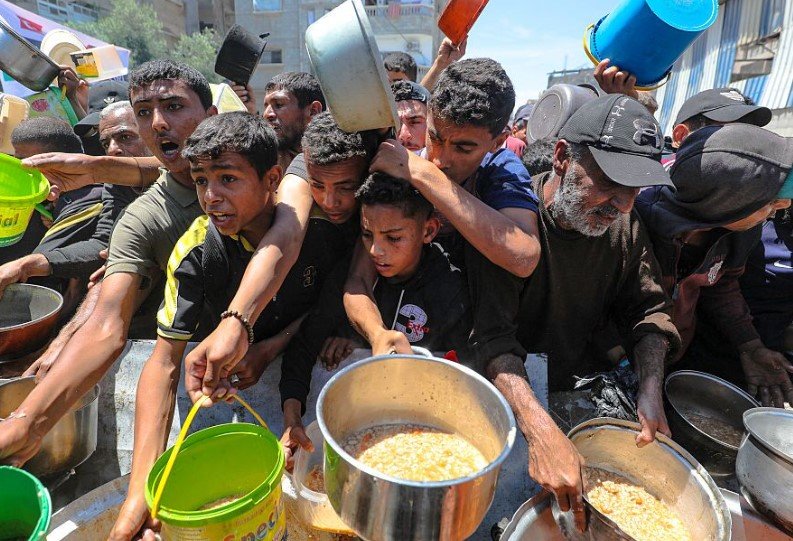The United Nations has raised fresh alarms about the slow pace of humanitarian aid reaching Gaza, even as a fragile ceasefire holds. Officials point to ongoing Israeli restrictions that limit supplies, leaving millions in the war-torn enclave facing severe shortages of food, water, and medicine as of November 2025.
Ceasefire Brings Hope But Aid Falls Short
The ceasefire agreement between Israel and Hamas took effect on October 10, 2025, aiming to halt over a year of intense conflict. It promised to allow 600 aid trucks into Gaza each day to address the dire humanitarian crisis.
Yet, reports show that only about 145 trucks have entered daily on average. This shortfall has sparked warnings from aid groups that famine risks remain high in northern Gaza, where access is especially limited.
UN officials note that while 37,000 metric tonnes of aid, mostly food, have arrived since the truce began, this is far below what’s needed for Gaza’s 2.3 million people. Many families still rely on sporadic distributions, and malnutrition cases continue to rise.

The World Food Programme has called for all border crossings to open fully. Without that, they say, the aid effort cannot scale up to prevent widespread hunger.
Israel Cites Violations for Restrictions
Israeli authorities have defended the limits by accusing Hamas of breaching the ceasefire terms. They claim the group has been slow to return bodies of deceased hostages, prompting reductions in aid flows.
Under the deal, Israel agreed to let in 600 trucks daily, including fuel and gas. But in late October 2025, officials announced they would cap it at 300 trucks and restrict fuel, tying it to hostage returns.
This move has drawn international criticism. A UN court ruling in mid-October urged Israel to ease restrictions, but compliance has been spotty.
Aid workers report that 107 requests for relief materials have been rejected since the ceasefire started. These denials block essential items like shelter materials and medical supplies.
Here are key restrictions noted in recent updates:
- Limited crossings: Only Kerem Shalom and Kissufim are operational, blocking direct access to northern and southern Gaza.
- Fuel shortages: No general fuel entries, only for specific needs, hampering water purification and hospital operations.
- Staff access: International NGO workers often denied entry, slowing distribution efforts.
Impact on Gaza’s Population
Palestinians in Gaza describe daily struggles amid the rubble of destroyed homes and infrastructure. In places like Jabalia and Khan Younis, people scavenge for food while Israeli forces conduct occasional raids, violating the truce.
Health experts warn of a looming health crisis. Without steady medicine supplies, diseases like cholera could spread in overcrowded shelters.
Children and the elderly suffer the most. Reports from aid groups indicate that acute malnutrition affects thousands, with some areas seeing child death rates climb since the ceasefire.
One resident in Deir al-Balah shared that food parcels reach only a fraction of those in need. Many wait days for basics like flour and canned goods.
The economic toll is massive too. With borders tight, local markets have collapsed, pushing prices sky-high for any available goods.
Global Response and Calls for Action
World leaders have stepped up pressure on Israel to honor the ceasefire fully. Singapore, for instance, urged expanded aid access in early November 2025, echoing calls from the UN and European nations.
The United States, which brokered the deal, has faced scrutiny for not enforcing terms more strictly. Recent diplomatic talks aim to resolve the hostage issue without cutting aid.
Aid organizations like UNRWA stress that without visa approvals for staff, operations grind to a halt. They report no international staff entries since January 2025.
To highlight the scale of the crisis, consider this breakdown of aid needs versus reality:
| Category | Daily Agreed Amount | Actual Daily Average | Shortfall Impact |
|---|---|---|---|
| Trucks | 600 | 145 | Delays food to 1 million people |
| Fuel | Unlimited for needs | Restricted to minimal | Power outages in hospitals |
| Food Parcels | Enough for 2.3M | Reached 1M so far | Rising hunger in north |
| Medical Supplies | Full access | 107 requests denied | Untreated injuries spike |
This table shows how gaps in aid delivery worsen the situation on the ground.
Path Forward Amid Uncertainty
Experts believe a full opening of crossings, including from Egypt, could turn the tide. But ongoing tensions, like reported Israeli strikes in late October, threaten the truce.
Long-term recovery will need billions in rebuilding funds. International donors have pledged support, but delivery hinges on stable access.
As winter approaches, the need for shelter and heating grows urgent. Aid groups race to stockpile before conditions deteriorate further.
Readers, what are your thoughts on this ongoing crisis? Share this article to raise awareness and comment below on ways to support humanitarian efforts.
